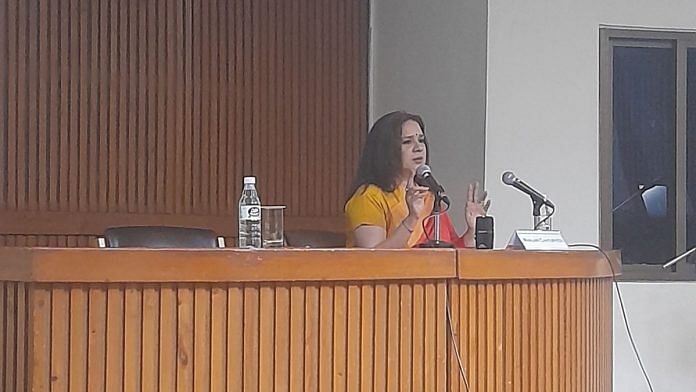Indian classical dancer Manjari Chaturvedi wants to reclaim the tawaif or courtesan culture. She wants to get rid of the negative stereotypes, and she’s doing it through the songs they sang.
“Women did not write history, men did,” she said in a recent lecture, ‘The Lost Songs of the Courtesans’, at New Delhi’s India International Centre. It was part of IIC’s Music Appreciation Promotion (MAP) where 90-minute sessions are held monthly.
Today, the courtesan culture has faded from public memory, their art forgotten, and their songs lost. One of the last courtesans of the Awadh Court, Zareena Begum, lived in a dilapidated one-room house in Lucknow before she died in 2018.
There was a time when tawaifs exerted great influence over art, culture and the aesthetics of their time. This changed during the Raj, when the British reduced them to mere dancers.
“Many others were forgotten. Even academics are not talking about it,” said Chaturvedi. Few know about Begum Akhtar or Begum Samru – who married a British mercenary, or Rekhabai or Azeezunbai who played a part in the revolt of 1857. In India, Zareena Begum kept the tradition alive.
Chaturvedi recalled a 2014 Delhi event, ‘The Last Song of Awadh’, where she fulfilled Zareena’s final wish of singing in a mehfil (public gathering). “Zareena just wanted to wear her Banarasi saree and perform. She was paralysed and we had to bring her to the venue in a wheelchair but she sang for 90 minutes,” she said.
The dancer is bringing tawaifs’ songs and performances to life through ‘The Courtesan Project’, which she launched in 2011 under the banner of her Sufi Kathak Foundation. Chaturvedi, who considers herself a cultural academic, calls these performances “research papers”.
Through The Courtesan Project, she wants to erase the male gaze that continues to trap tawaifs. It’s the male gaze, she argues, that reduced these women from artistes to those who only performed for the pleasure of men. And so, they were spoken about in hush-hush tones, if not ignored.
But artistes, historians and filmmakers like Chaturvedi are challenging this by bringing the tawaif culture back to the mainstream. The most recent example is Sanjay Leela Bhansali’s series Heeramandi—slated to be released on Netflix—which promises to be an extravagant recreation of a time when dance, poetry, music and tawaifs were celebrated. In her 2009 documentary, The Other Song, Saba Dewan travels to Varanasi, Lucknow and Muzaffarpur to explore the courtesan culture.
“Male artistes are called ‘ustads’. But there is no ‘padvi’ for women performers. Why?” said Chaturvedi.
Bollywood popularised stereotypes
Through the lecture, Chaturvedi, the creator of ‘Sufi Kathak’, introduced to the audience some ‘lost songs’ and their sufi iterations, as well as songs that were adapted by Bollywood. The audience swayed and tapped their feet to Bajuband Khul Khul Jaaye, Bahut Kathin Hai, and Mohe Panghat, among others.
But Bollywood commercialised courtesan music without giving them enough credit, she said. She cited Mughal-e-Azam (1960) as an example. With a troupe of Kathak dancers in the background, legendary actor Madhubala dances to the courtesans’ music, but there is no mention of any courtesan in the end credits.
There is no written record of when and who sang a particular song first. Most were passed down orally. But Bollywood lyricists have claimed ownership of these, said Chaturvedi.
And filmmakers perpetuated and popularised the stereotype. Hindi cinema magnified the male gaze. The dances were eroticised, and alcohol remained a constant in all visuals showcasing courtesans.
The dance was not seen as an art form in isolation but how it made the man feel–an added performance to the plot.
While there are hardly any recorded videos of tawaifs’ performances, Chaturvedi showed her audience a video of a courtesan singing a composition while being seated with a band of classical musicians.
What we see in popular culture today is an incomplete picture focusing on just one aspect of their lives. It negates their art and talent, an integral part of their identity.
Also read: ‘I Will Draw my Own Laxman Rekha’—Gogi Saroj Pal reimagines Indian myths free of male gaze
‘Kathak was cleaned up’
Although the British could be blamed for misunderstanding and misrepresenting the durbari culture of kathak and tawaifs, the dance form is still popular among Indians. However, a conspicuous absence in historical discourse remains— the “deliberate” omission of women dancers from the 1930s to the 1950s.
But it’s lazy to simply blame colonisers.“Why wasn’t this [a revival] taken up post-Independence?” asked Chaturvedi. “Kathak is encouraged, but mujra is called cheap.”
Kathak was cleaned up after Independence, said Chaturvedi, but there’s still a collective amnesia about tawaifs. They’ve been systematically erased.
Chaturvedi hopes to recreate renditions that closely resemble their original recordings – no altered lyrics, and with due credit to tawaifs. “I will ensure that at least in my lifetime, mujra or tawaif are not bad words.”
(Edited by Zoya Bhatti)



